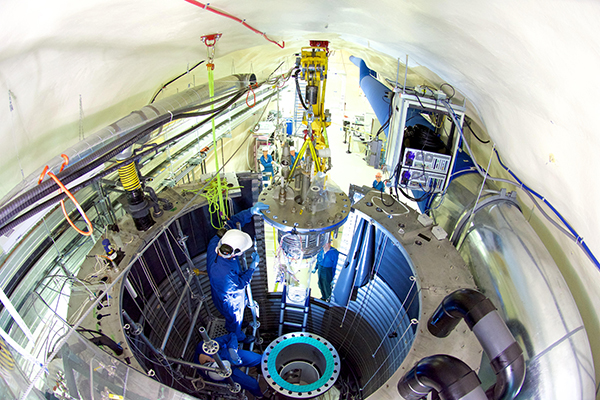
A team of University of Alberta researchers worked with collaboration members to upgrade the PICO-60 detector at SNOLAB. Photo courtesy PICO/SNOLAB.
The first bubble chamber was created in the 1950s and quickly became the most popular apparatus for studying subatomic particles. Since then, other types of detectors have surpassed bubble chambers in speed, but a modern bubble chamber upgraded by a team of University of Alberta researchers has yielded new insights into dark matter.
The PICO-60 collaboration recently announced a new dark matter limit after analysis of data from its second - and last - run. The results mean that physicists have identified more specific parameters in the search for dark matter.
"The new fill and operation of the PICO-60 detector could really not have gone any better," says Carsten Krauss, an associate professor of physics at the University of Alberta and the lead scientist of the PICO-60 collaboration. "The excellent result shows not only that bubble chambers have an excellent role to play in the quest for the discovery of dark matter, but it also shows that the PICO collaboration has developed the deep knowledge of the technology needed to push dark matter searches with the planned next generation bubble chambers."
New generation of bubble chambers
PICO-60 is housed at SNOLAB, the underground neutrino research facility that uses old mine shafts near Sudbury, Ontario. Recent upgrades to the detector were led by Krauss and his research group at the University of Alberta. The team devised a new optical camera system and improved detector cleanliness to ensure the experiment went off without a hitch.
It was a big job. PICO-60 is the world's largest bubble chamber in operation and is filled with 52 kg of C3F8 (octafluoropropane). The detector uses the target fluid in a superheated state such that a dark matter particle interaction with a fluorine nucleus causes the fluid to boil and creates a tell-tale bubble in the chamber. Digital cameras capture the bubbles and acoustic pickups improve the ability to distinguish between dark matter particles and other sources when analyzing data.
While aspects of the PIC0-60 are continuing - Scott Fallows, a UAlberta postdoctoral fellow, now leads the experiment - the detector has completed its dark matter runs and will be replaced by PICO-40L, a new, better detector that is scheduled to go online later this year.
"We are again responsible for the camera system, the data acquisition in general, several aspects of the acoustic data taking, and the thermal design," says Krauss, co-leader of the PICO-40L experiment. "Parts of the new detector are already in the labs at CCIS (on the University of Alberta campus) to be tested and verified. Some parts will be machined in the radon-free clean room in the basement of CCIS, that was also used for the DEAP and SNO+ experiments in the past."
New eyes on the universe
The PICO, DEAP and SNO+ experiment are three of several SNOLAB experiments in which University of Alberta researchers play large roles. They are featured in a new exhibit, entitled New Eyes on the Universe, that showcases the SNOLAB-based research that led to the 2015 Nobel Prize in physics. The exhibit includes videos, images, maquettes, and artifacts from the detectors at SNOLAB. The exhibit is at the Telus World of Science Edmonton (TWoSE) until April 2, 2017. Access to the exhibit is included in the admission to TWoSE.
PICO partners
The PICO experiment is an international collaboration that includes 17 institutional partners: the University of Alberta; the University of Chicago; Czech Technical University; Fermilab; Indiana University South Bend; the Kavli Institute for Cosmological Physics; Laurentian University; Université de Montréal; Northeastern Illinois University (NEIU); Northwestern University; Universidad Nacional Autonoma de Mexico; Pacific Northwest National Laboratory; Queen's University at Kingston; the Saha Institute of Nuclear Physics, India; SNOLAB; Universitat Politecnica de Valencia; and Virginia Tech.